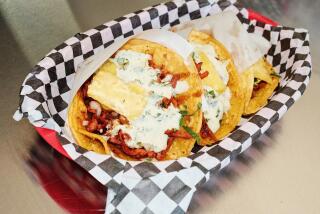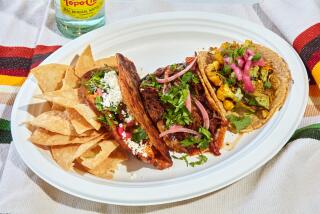Edible seaweed is the star of this coastal forager’s tour
- Share via
“The problem with foraging for mushrooms is you can mistake a toxic variety for an edible one and wind up dead,” Spencer Marley said.
On a warm autumn afternoon, he led my family along a trail in Estero Bluffs State Park, three miles north of Cayucos, Calif. “When you forage for seaweed, you don’t have to worry. Seaweed is nontoxic unless it’s contaminated by polluted water near a city, a power plant or the mouth of a river. That’s why I take my seaweed-foraging tours here, far from any of those things.”
We followed the burly 38-year-old down a gully to a deserted beach, where gentle waves lapped the tide pools and cormorants dived for fish in the kelp forest. I could see why Marley had assured me this was the ideal place to forage for seaweed while social distancing.
He’s the owner of Marley Family Seaweeds and has led seaweed-foraging tours for more than a year. He began shortly after he started gathering and drying edible seaweed to sell online and at farmers markets.
“In college I majored in journalism, but summers I worked on fishing boats and realized the sea was calling to me,” he said. “I spent 10 years on oil-spill-response vessels, then was foreman at the Morro Bay Oyster Co. When my family grew to five, I realized I needed a job on land.”
Marley knew that seaweed was used as food in Asian countries, including Japan, and in Ireland, where his ancestors were from. Through research he discovered several varieties of edible seaweed on California’s Central Coast. “Seaweed is an algae, not a plant, and it’s far richer in nutrients than most vegetables grown on land,” he said. “I believed there was a market for it here.”
My daughter was eager to join the day’s tour. She had learned the joys of foraging while picking wild blackberries in the Pacific Northwest. Her sons, ages 6 and 9, were psyched to be here too. Like many L.A. kids, their favorite foods are sushi, which is wrapped in seaweed, and ramen, Japanese noodle soup. Marley promised to cook them delicious ramen with the fresh seaweed we would gather.
He passed out colander baskets and grape-snipping shears. “Seaweed is grown on rocks in the ocean, some of which are exposed when the tide is low,” he said. “If you carefully cut off the edible parts, what we call the blades, they’ll grow back in a few months.” He led us along the shoreline as he scanned the water. “Sometimes ocean swells make our job easier by knocking off the blades and washing them ashore. The trick is harvesting them while they’re still wet.“
He scooped up a handful of what looked like delicate curly lettuce leaves floating in the water. “This is ulvaor sea lettuce, he said, offering us tastes. The flavor reminded me of spinach.
My grandsons, knee-deep in water, began a tug-of-war with a long stalk of kelp. “Kelp is called kombu in Japan,” said Marley. “It’s the basic ingredient in dashi, the ramen broth.” He pointed to the ridges on the kelp’s greenish-brown blades. “But this is giant kelp. It’s fun to play with but not very tasty.” He scooped up a smooth yellowish kelp blade. “What we want is this blade from bull kelp.” He dropped it into his foraging basket. “It will add tons of umami flavor to our dashi.”
My daughter picked up a reddish-brown kelp blade covered with stiff bumps. “Is this edible?” she asked.
Marley shook his head. “That’s what we call Turkish towel. If you dry it, you can use it as a shower scrub,” he said. “But I have to warn you it could make your bathroom smell like a tide pool.” That didn’t deter my daughter. She went on a hunt for more Turkish towel to take home.
We approached a boulder still wet from the receding tide. It was covered with small dark-green algae. “This is nori seaweed,” said Marley. He cut off a few tiny blades and offered them to my grandsons. “Taste familiar?”
They nibbled cautiously. “Like seaweed snacks mom gets us at Trader Joe’s,” said my older grandson. “Like sushi wrappers,” said the younger one.
Marley said that 90% of nori seaweed is farmed in Japan, China and South Korea. “They grow it on long ropes, then grind it into a paste, roll it into sheets and dry them in a super-hot oven,” he said. “Our nori is wild and hand-harvested sustainably. We dry it in the sun the way it was done traditionally for thousands of years.”
Marley waded into the water in search of golden rockweed. He returned with a handful of what looked like tiny greenish-brown bushes. My daughter took a taste. “Wow, it’s like a cross between olives and capers,” she said.
“My kids love it in pasta,” Marley said.
When our foraging baskets were full, we rinsed the sea lettuce, bull kelp, nori and golden rockweed in the ocean. Marley propped a portable propane stove on a driftwood log, heated a pot on it, then added chopped fresh onion and garlic. When they were browned, he poured in water and a generous splash of dark soy sauce. The broth soon came to a boil. He added the seaweed and, a few minutes later, dried ramen noodles.
My grandsons were first in line when the ramen was served. We sat on the warm sand above the tideline, savoring the umami-rich broth and the distinctive tastes and textures of the various seaweeds. We thanked Marley for the seaweed-foraging tour and this culinary treat.
“Don’t forget, seaweed is so rich in minerals and vitamins it’s considered a superfood like kale,” he said. “So with what you learned today, if you’re ever stranded on a deserted island, you’ll know how to survive on seaweed.”
If you go
Marley offers 90-minute group seaweed-foraging tours on Saturdays at 2:30 p.m. by reservation only. Make reservations at Marley Family Seaweeds or (805) 441-3603. $105 per person, including the ramen lunch. Meet at the Fig Tree parking area of Estero Bluffs State Park, about a 3 1/2-hour drive from Los Angeles. Dress in layers and wear old sneakers for walking. You are allowed to bring home up to 10 pounds of seaweed without a California sport fishing license.
If you would like to forage for seaweed on your own, Marley suggests downloading this free PDF about Pacific seaweeds in the journal of the California Native Plant Society. The best edible seaweeds on the Central Coast include those mentioned above as well as wakame and grapestone. Good locations to forage include Estero Bluffs State Park, San Simeon and Big Sur. If you wish to bring home more than 10 pounds of foraged seaweed, you must obtain a one-day California sport fishing license for $15.69 at wildlife.ca.gov/licensing/online-sales.
For places to stay and other activities near Central Coast seaweed-foraging sites, go to highway1discoveryroute.com.
More to Read
Sign up for The Wild
We’ll help you find the best places to hike, bike and run, as well as the perfect silent spots for meditation and yoga.
You may occasionally receive promotional content from the Los Angeles Times.






